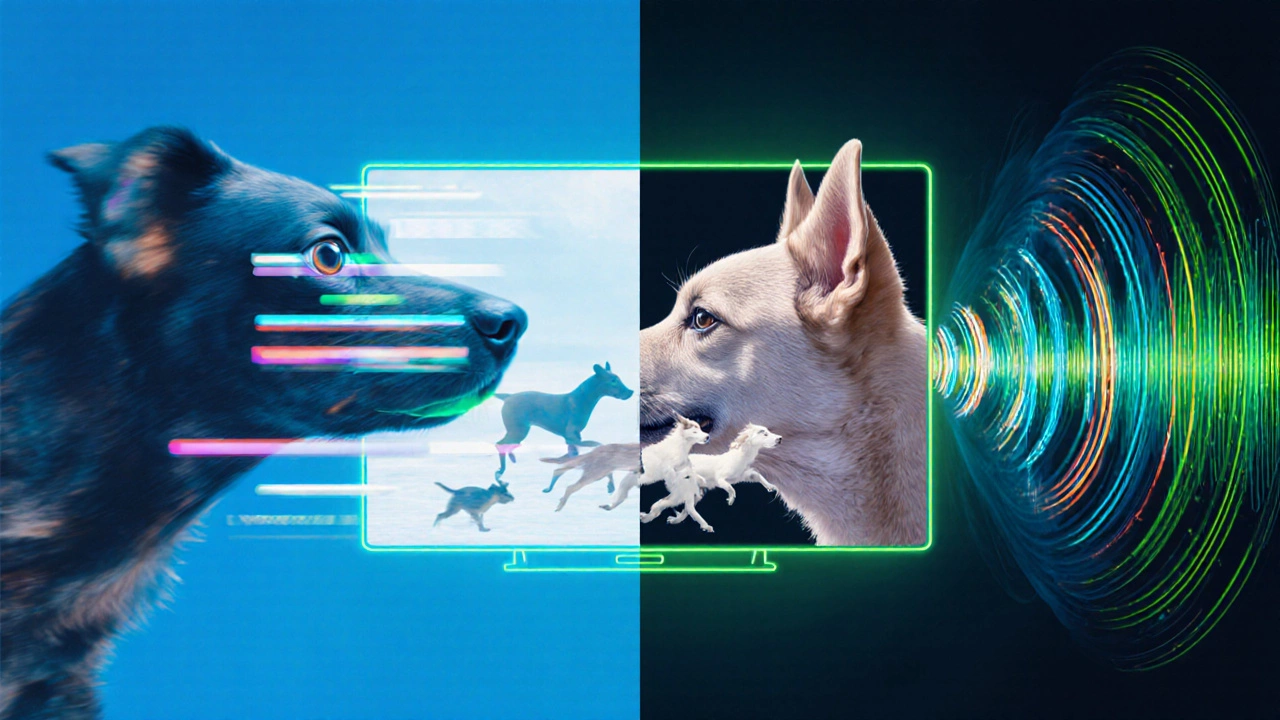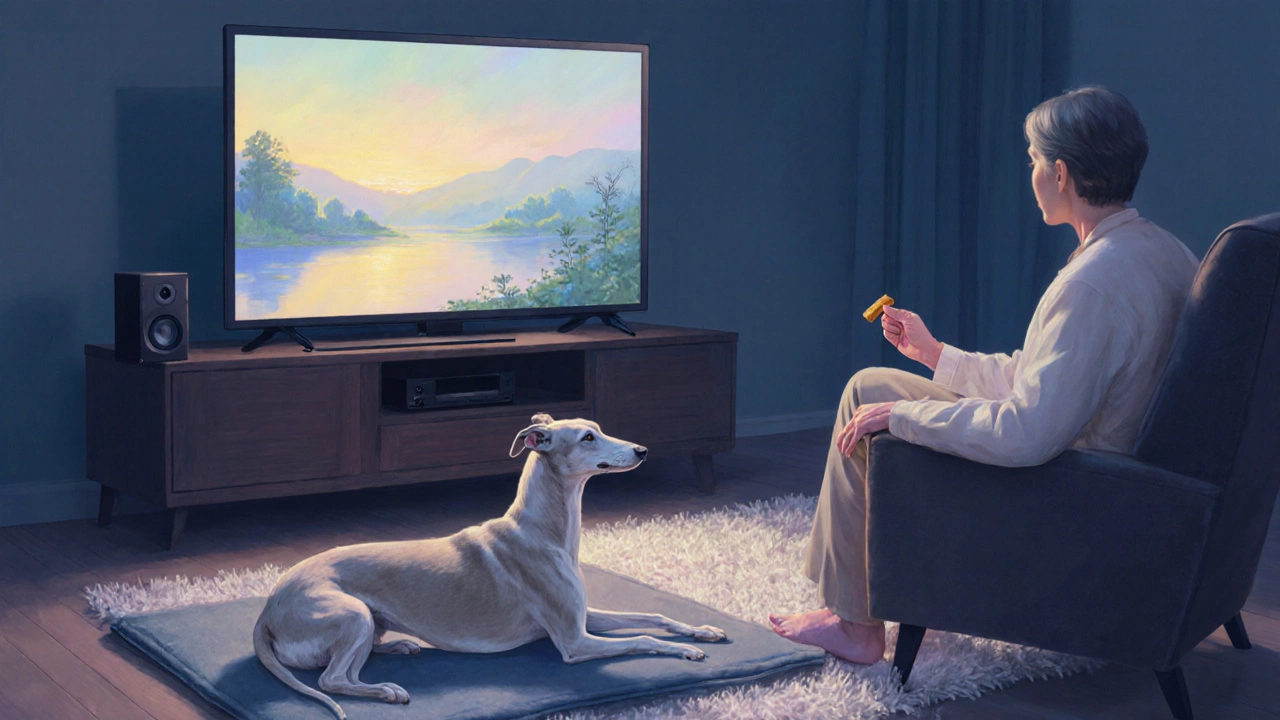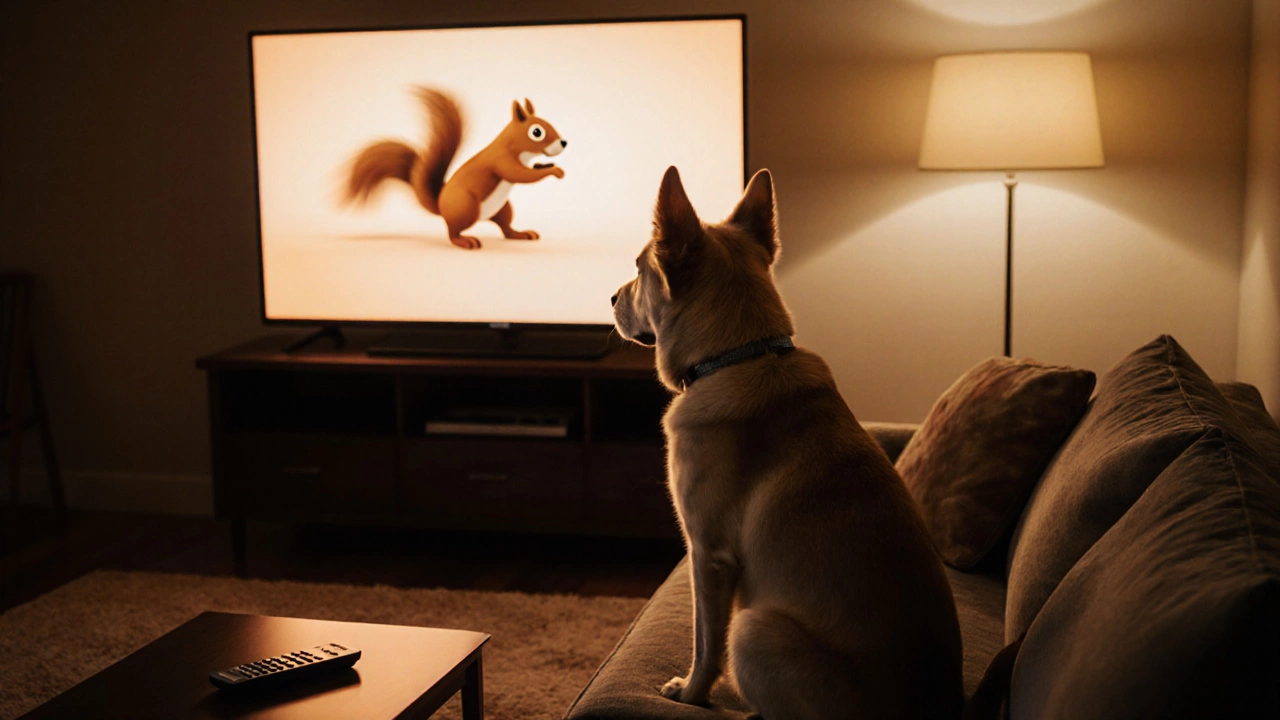Dog TV Reaction Calculator
Predict Your Dog's TV Reaction
Key Takeaways
- Dogs see TV differently - motion and sound matter more than picture detail.
- Breeds with strong prey drive or high energy often react to moving objects on screen.
- Only a few programs are designed for canine viewers; most TV isn’t harmful but can cause overstimulation.
- Gradual exposure, volume control, and safe viewing spots keep TV time positive for your pet.
- If your dog shows signs of stress, it’s better to turn the screen off and switch to a calming activity.
Ever caught your Dogs domesticated canines that have lived alongside humans for thousands of years staring at the TV and wondered if they actually like the show? You’re not alone. Many pet parents notice a tail wag, a perked ear, or a sudden bark when a screen lights up. The truth is a mix of science, breed personality, and the way TV delivers visual and auditory cues.
Below we break down how Television an electronic device that displays moving images and sound interacts with a dog’s senses, what typical reactions look like, and practical tips to make screen time a low‑stress activity.
How Dogs Perceive TV: Vision and Hearing
Understanding a dog's reaction starts with two key senses.
- Vision: Dogs have a higher flicker fusion threshold than humans, meaning they need a faster refresh rate to see smooth motion. Older TV models (below 60Hz) can appear as a series of static frames, which often looks like a jittery insect to a canine.
- Hearing: Canine hearing ranges roughly from 40Hz to 60kHz, far beyond the human upper limit of 20kHz. This makes the Audio sound component of a broadcast, including dialogue, music and effects on TV especially attention‑grabbing for dogs.
Because dogs see less color detail (they’re dichromatic) but are highly attuned to motion and sound, a sudden bark or a zooming squirrel can be more stimulating than the actual picture quality.
Why Some Dogs React Strongly
Not every pooch will sit and watch a drama. Several factors drive a dog's response:
- Breed instincts: Terriers, hounds, and herding breeds have a natural chase instinct. Fast‑moving objects on screen can trigger a predatory response.
- Energy level: High‑energy dogs need outlets. A flashing screen can become a temporary playmate.
- Past experiences: Dogs that have been rewarded for reacting to sounds (e.g., receiving treats for barking) may repeat the behavior.
- Age and health: Senior dogs with vision loss may be less interested, while puppies often explore everything, including the TV.
When a dog notices something on the screen, you might hear a Barking vocalization dogs make to express excitement, alertness, or anxiety spurt, a stare, or even a playful pounce at the floor.

TV Content That Catches a Dog’s Eye
Most mainstream programs aren't made for canine viewers, but certain elements draw their attention:
- Fast motion: Running animals, cars, or quick cuts.
- High‑pitched sounds: Bird chirps, squeaky toys, or whistles.
- Contrasting colors: Though dogs see fewer colors, bright yellows and blues stand out.
There are also niche shows like "DogTV" that use calming colors, moderate motion, and frequencies dogs can hear. These programs are designed to reduce anxiety when owners are away.
Practical Tips for Safe TV Time
- Choose the right spot: Place the dog’s bed or mat a few feet from the screen. This limits intense focus and prevents accidental collisions.
- Control the volume: Keep it at a level where you can still converse with your dog. If you notice ears flattening or tail tucking, lower it.
- Limit sessions: Start with short 5‑minute intervals. Observe behavior and gradually increase if the dog stays calm.
- Use positive reinforcement: Reward calm sitting with treats. This teaches your pet that relaxed watching equals good things.
- Watch for stress signals: Panting, pacing, or compulsive barking indicate the TV is overstimulating. Turn it off and switch to a walk or chew toy.
Remember, the goal isn’t to make your pet a TV critic but to ensure the background noise is harmless and, if possible, enriching.
Common Myths About Dogs and TV
Here are a few misconceptions that pop up often:
- My dog watches TV like a human. Dogs lack the narrative comprehension humans have. They react to sensory cues, not storylines.
- All dogs love TV. As we saw, breed, age, and personality matter. Some dogs may barely notice a screen.
- TV reduces boredom for every dog. For some, it can actually increase anxiety, especially if the content is loud or fast.

When TV Might Be a Problem
If your dog consistently shows signs of distress when the TV is on, consider these steps:
- Turn off the TV during feeding or sleep times to create a calm environment.
- Provide alternative enrichment: puzzle toys, chew sticks, or interactive play.
- Consult a vet or certified behaviorist if the anxiety seems severe.
In many cases, a simple adjustment of volume and content can transform a stressful background into a soothing ambience.
Quick Reference Table
| Reaction | Likely Trigger | Common Breeds |
|---|---|---|
| Focused stare | Fast‑moving animal | Border Collie, Australian Shepherd |
| Light barking | High‑pitched sounds | Beagle, Terrier mixes |
| Tail wagging | Playful animation | Labrador Retriever, Golden Retriever |
| Stress signs (panting, pacing) | Loud explosions, rapid cuts | Any breed, especially seniors |
| Indifference | Static or low‑movement scenes | Greyhound, older dogs |
Bottom Line
Dogs don’t watch TV for the plot; they react to motion, sound, and the energy you bring into the room. By matching content to your dog’s senses, keeping volume sensible, and rewarding calm behavior, you can turn the TV into a neutral or even pleasant backdrop. And if your dog shows clear signs of stress, it’s best to switch off the screen and find a quieter way to keep them engaged.
Frequently Asked Questions
Do dogs understand what’s happening on screen?
No. Dogs lack the cognitive ability to follow a storyline. They respond to moving shapes, bright contrasts, and especially sounds that match their hearing range.
Is it safe to leave the TV on when I’m out?
For most dogs, a low‑volume, non‑intense program won’t cause harm. However, if your dog shows anxiety or becomes overly excited, it’s safer to turn it off and give them a safe chew toy.
Are there TV channels made for dogs?
Yes. Services like DogTV design programming with slower motion, muted colors, and frequencies that calm canines. These can be useful when owners are away for long periods.
What volume is ideal for canine viewers?
Keep it under 60dB - roughly the level of normal conversation. If you need to raise your voice to be heard by your dog, the volume is too high.
Can watching TV help reduce a dog’s separation anxiety?
Occasionally, a calming background can distract a nervous dog, but it shouldn’t replace proper training or companionship. Use TV as a supplement, not a cure.
